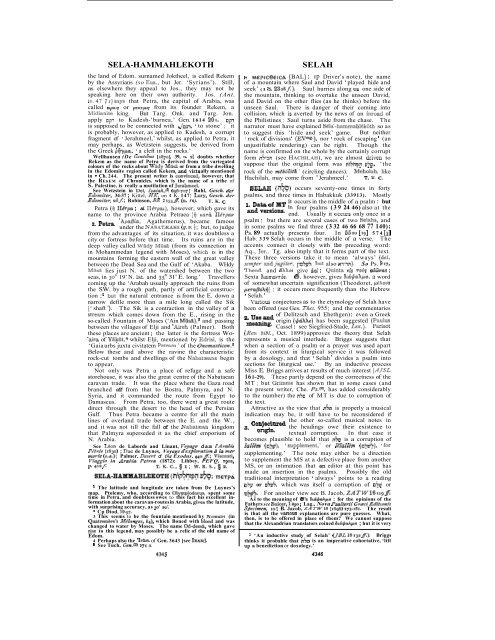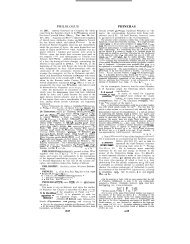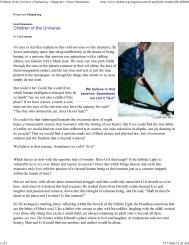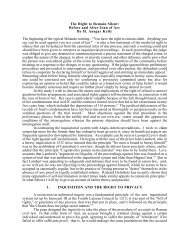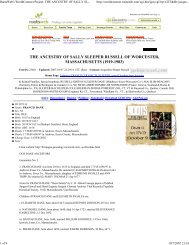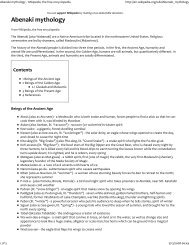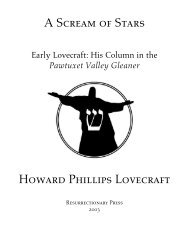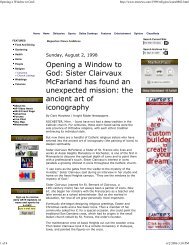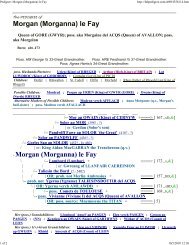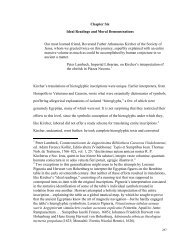sefi;g:v. - A Kabbalist walks into a bar, and the
sefi;g:v. - A Kabbalist walks into a bar, and the
sefi;g:v. - A Kabbalist walks into a bar, and the
Create successful ePaper yourself
Turn your PDF publications into a flip-book with our unique Google optimized e-Paper software.
SELA-HAMMAHLEKOTH SELAH<br />
<strong>the</strong> l<strong>and</strong> of Edom. surnamed Jok<strong>the</strong>el, is called Rekem<br />
by <strong>the</strong> Assyrians (so Eus., but Jer. ‘Syrians’). Still,<br />
H MEpiceaica [BAL] ; cp Driver’s note), <strong>the</strong> name<br />
of a mountain where Saul <strong>and</strong> David ’ played hide <strong>and</strong><br />
as elsewhere <strong>the</strong>y appeal to Jos., <strong>the</strong>y may not be<br />
speaking here on <strong>the</strong>ir own authority. Jos. (Ant.<br />
seek’ (I S. 2328J). Saul hurries along on one side of<br />
<strong>the</strong> mountain, thinking to overtake <strong>the</strong> unseen David,<br />
iv. 47 71)says that Petra, <strong>the</strong> capital of Arabia, was <strong>and</strong> David on <strong>the</strong> o<strong>the</strong>r flies (as he thinks) before <strong>the</strong><br />
called U~KT or PEKE,U~ from its founder Rekem, a unseen Saul. There is danger of <strong>the</strong>ir coming <strong>into</strong><br />
hlidianite king. But Targ. Onk. <strong>and</strong> Targ. Jon.<br />
apply op-1 to Kadesh-‘<strong>bar</strong>nea,’ Gen. 1614 201. opi<br />
is supposed to be connected with doli, ‘ to stone’ ; it<br />
collision, which is averted by <strong>the</strong> news of an inroad of<br />
<strong>the</strong> Philistines ; Saul turns aside from <strong>the</strong> chase. The<br />
narrator must have explained Wd-hammahlEk6th so as<br />
is probably, however, as applied to Kadesh, a corrupt<br />
fragment of ‘ Jerahmeel,’ whilst, as applied to Petra, it<br />
to suggest this ‘hide <strong>and</strong> seek’ game. But nei<strong>the</strong>r<br />
‘ rock of divisions ’ ( EVmg.), nor ‘ rock of escaping ’ (an<br />
may perhaps, as Wetzstein suggests, be derived from<br />
<strong>the</strong> Greek fiijypa, ‘ a cleft in <strong>the</strong> rocks.’<br />
Wellhausen (De Genfzdrrs [1870], 39, n. 2) doubts whe<strong>the</strong>r<br />
Rekem as <strong>the</strong> name of Petra is derived from <strong>the</strong> variegated<br />
colours of <strong>the</strong> rocks about WZdy MfisZ or from a tribe dwelling<br />
in <strong>the</strong> Edomite region called Kekem <strong>and</strong> virtually mentioned<br />
in T Ch. 244. The present writer is Lonvinced, however, that<br />
<strong>the</strong> REKEM of Chronicles. which is <strong>the</strong> name of a tribe of<br />
S. Palestine, is really a mutilation of Jerabmeel.<br />
See Wetzstein in Del. Zsaia/t,(9 696-707 ; Buhl, Gesch. der<br />
Edomfer, 34-37 ; Kittel, HK, on 2 K. 147 : Lury, Gesch. der<br />
Edowzifer, z8J: Robinson, BR 2 653H. (n. 36). T. K. c.<br />
Petra Q &+pa ; ai IICrpai), however, which gave its<br />
name to <strong>the</strong> province Arabia Petraea (ij KaTb IIirpav<br />
2. ‘Apapia, Aga<strong>the</strong>merus), became famous<br />
under <strong>the</strong> NABATBANS (a,.. ); but, to judge<br />
from <strong>the</strong> advantages of its situation, it was doubtless a<br />
city or fortress before that time. Its ruins are in <strong>the</strong><br />
deep valley called WBdy MiisH (from its connection in<br />
in Mohammedan legend with Moses), u-hich is in <strong>the</strong><br />
mountains forming <strong>the</strong> eastern wall of <strong>the</strong> great valley<br />
between <strong>the</strong> Dead Sea <strong>and</strong> <strong>the</strong> Gulf of ‘Akaba. WHdy<br />
MfisH lies just N. of <strong>the</strong> watershed between <strong>the</strong> two<br />
seas, in 30’ 19’ N. lat. <strong>and</strong> 35’ 31’ E. long.’ Travellers<br />
unjustifiable rendering) can be right. Though <strong>the</strong><br />
name is confirmed on <strong>the</strong> whole by <strong>the</strong> certainly corrupt<br />
form nhn (see HACHILAH), we are almost driven to<br />
suppose that <strong>the</strong> original form was ni%np? yip, ‘<strong>the</strong><br />
rock of <strong>the</strong> rn@Z6th ’ (circling dances). Mehoiah, like<br />
Hachilah, may come from ‘ Jerahmeel.’ T. K. c.<br />
SELAH (+Dl occurs seventy-one times in forty<br />
psalms, <strong>and</strong> three times in Habakkuk (33913). Mostly<br />
1. DItta of MT ft occurs in <strong>the</strong> middle of a psalm ; but<br />
in four psalms (3 9 24 46) also at <strong>the</strong><br />
alld end. Usually it occurs only once in a<br />
psalm : but <strong>the</strong>re are several cases of two Selahs, <strong>and</strong><br />
in some psalms we find three (3 32 46 66 68 77 140) ;<br />
Ps. 89 actually presents four. In 5520 [xg] 574 [3]<br />
Hab. 339 Selah occurs in <strong>the</strong> middle of a verse. The<br />
accents connect it closely with <strong>the</strong> preceding word:<br />
Aq., Jer., Tg. also imply that it forms part of <strong>the</strong> text.<br />
These three versions take it to mean ‘always’ (del,<br />
seinppr <strong>and</strong>jugiter, ]+asp$, but also m’in). So Ps. 917,<br />
Theod. <strong>and</strong> EihXos give del ; Quinta Els 703s a&us ;<br />
Sexta Graaavrbs. 6, however, gives GidqaXpa, a word<br />
coming up <strong>the</strong> ‘Arabah usually approach <strong>the</strong> ruins from of somewhat uncertain signification (Theodoret, pbXous<br />
<strong>the</strong> SW. by a rough path, partly of artificial construc- pmu@X$) ; it occurs more frequently than <strong>the</strong> Hebrew<br />
tion ; but <strong>the</strong> natural entrance is from <strong>the</strong> E. down a<br />
z Selah. ’<br />
narrow defile more than a mile long called <strong>the</strong> Sik L‘arious conjectures as to <strong>the</strong> etymology of Selah have<br />
(‘ shaft ‘). The Sik is a contraction in <strong>the</strong> valley of a<br />
stream which comes down from <strong>the</strong> E., rising in <strong>the</strong><br />
so-called Fountain of Moses (‘Ain MI~sZ),~ <strong>and</strong> passing<br />
between <strong>the</strong> villages of Elji <strong>and</strong> ‘Aireh (Palmer). Both<br />
<strong>the</strong>se places are ancient : <strong>the</strong> latter is <strong>the</strong> fortress Wobeen<br />
offered (see Ges. Thes. 955 ; <strong>and</strong> <strong>the</strong> commentaries<br />
a. Use<strong>and</strong> of Delitzsch <strong>and</strong> Ehethgen) ; even a Greek<br />
origin (qdXXe) has been suggested (Paulus<br />
mew* Cassel ; see Siegfried-Stade, fiz.). Parisot<br />
(Rm. dibl., Oct. 1899) approves <strong>the</strong> <strong>the</strong>ory that Selah<br />
‘aka of Y2ktX4 whilst Elji, mentioned by Edrisi, is <strong>the</strong> represents a musical interlude. Briggs suggests that<br />
‘Gaia urbs juxta civitatem Petram ’ of <strong>the</strong> Onomasti~on.~ when a section of a psalm or a prayer was used apart<br />
Below <strong>the</strong>se <strong>and</strong> above <strong>the</strong> ravine <strong>the</strong> characteristic<br />
rock-cut tombs <strong>and</strong> dwellings of <strong>the</strong> Nabataeans begin<br />
from its context in liturgical service it was followed<br />
by a doxology, <strong>and</strong> that ‘ Selah ’ divides a psalm <strong>into</strong><br />
to appear.<br />
Not only was Petra a place of refuge <strong>and</strong> a safe<br />
storehouse, it was also <strong>the</strong> great centre of <strong>the</strong> Nabataean<br />
sections for liturgical use.’ By an inductive process<br />
Miss E. Briggs arrives at results of much interest (AYSL<br />
16 1-29). These partly depend on <strong>the</strong> correctness of <strong>the</strong><br />
caravan trade. It was <strong>the</strong> place where <strong>the</strong> Gaza road MT ; but Grimme has shown that in some cases (<strong>and</strong><br />
branched off from that to Bostra, Palmyra, <strong>and</strong> N.<br />
Syria, <strong>and</strong> it comm<strong>and</strong>ed <strong>the</strong> route from Egypt to<br />
<strong>the</strong> present writer, Che. PJ.(~), has added considerably<br />
to <strong>the</strong> number) <strong>the</strong> nh of MT is due to corruption of<br />
Damascus. From Petra, too, <strong>the</strong>re went a great route <strong>the</strong> text.<br />
direct through <strong>the</strong> desert to <strong>the</strong> head of <strong>the</strong> Persian Attractive as <strong>the</strong> view that 2 3 is ~ properly a musical<br />
Gulf. Thus Petra became a centre for all <strong>the</strong> main<br />
lines of overl<strong>and</strong> trade between <strong>the</strong> E. <strong>and</strong> <strong>the</strong> W.,<br />
<strong>and</strong> it was not till <strong>the</strong> fall of <strong>the</strong> Nabatean kingdom<br />
that Palmyra superseded it as <strong>the</strong> chief emporium of<br />
indication may be, it will have to be reconsidered if<br />
<strong>the</strong> o<strong>the</strong>r so-called musical notes in<br />
3.<br />
<strong>the</strong> headings owe <strong>the</strong>ir existence to<br />
^--I<br />
u1 ‘SU.<br />
textual corruption. In that case it<br />
N. Arabia.<br />
See Leon de Laborde <strong>and</strong> Linant, VoyaEe dam rArarhie<br />
PitrPe (1830) ; Duc de Luynes, Voyage Gexjloration 2 Za mer<br />
nrorfe (sa.); Palmer, Deserf of fhe Exodus, ++os; Visconti,<br />
Viaggo in AraBia Petrea (1872); Lihbey, PEFQ, rgoz,<br />
P. 412J T.K.C.,§I; W.R.S.,§2.<br />
becomes plausible to hold that is a corruption of<br />
Sazlm (&), ‘supplement,’ or @“allZm (OS&), ‘for<br />
supplementing.’ The note may ei<strong>the</strong>r be a direction<br />
to supplement <strong>the</strong> MS at a defective place from ano<strong>the</strong>r<br />
MS, or an intimation that an editor at this point has<br />
made an insertion in <strong>the</strong> psalms. Possibly <strong>the</strong> old<br />
1 The latitude <strong>and</strong> longitude are taken from De Luynes’s<br />
map. Ptolemy, who, according to Olympiodorus, spent some<br />
time in Petra, <strong>and</strong> doubtless owes to this fact his excellent information<br />
about <strong>the</strong> caravan-routes in Arabia, zives <strong>the</strong> latitude,<br />
with surprising accuracy, as 30’ 20‘.<br />
a Cp Diod. 1997.<br />
3 This seems to be <strong>the</strong> fountain mentioned by Nowairi (in<br />
Quatremsre‘s Milnnges, 84), which Boned with blood <strong>and</strong> was<br />
changed to water by Moses. The name Od-demB, which gave<br />
rise to this legend, may possibly be a relic of <strong>the</strong> old name of<br />
Edom.<br />
4 Perhaps also <strong>the</strong> ‘IrBm of Gen. 3643 [see IRAM].<br />
6 See Tuch, Gen.P) 271 n.<br />
traditional interpretation always ’ points to a reading<br />
osy or 03~5, which was itself a corruption of o$& or<br />
&w!. For ano<strong>the</strong>r view see B. Jacob, ZATWl61%9&<br />
As to <strong>the</strong> meaning of @‘s Gr&$dpr : for <strong>the</strong> opinions of <strong>the</strong><br />
Fa<strong>the</strong>rs see Suicer, 18p ; Lag., Nova PsaZfe++i Grr~ci Edifzonis<br />
S#ecimrn, IO; B. Jacob, ZATWlS (r896) ~73-181. The result<br />
is that all <strong>the</strong> vanous explanations are pure guesses. What,<br />
<strong>the</strong>n, is to be offered in place of <strong>the</strong>m? We cannot suppose<br />
that <strong>the</strong> Alex<strong>and</strong>rian translators coined Grd$aApa ; hut it is very<br />
1 ‘An inductive study of Selah’ (/BL18132f.). Briggs<br />
thinks it probable that is an imperative cohortative, ‘lift<br />
up a benediction or doxology.’<br />
4345<br />
4346


